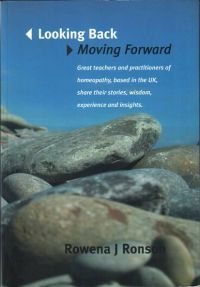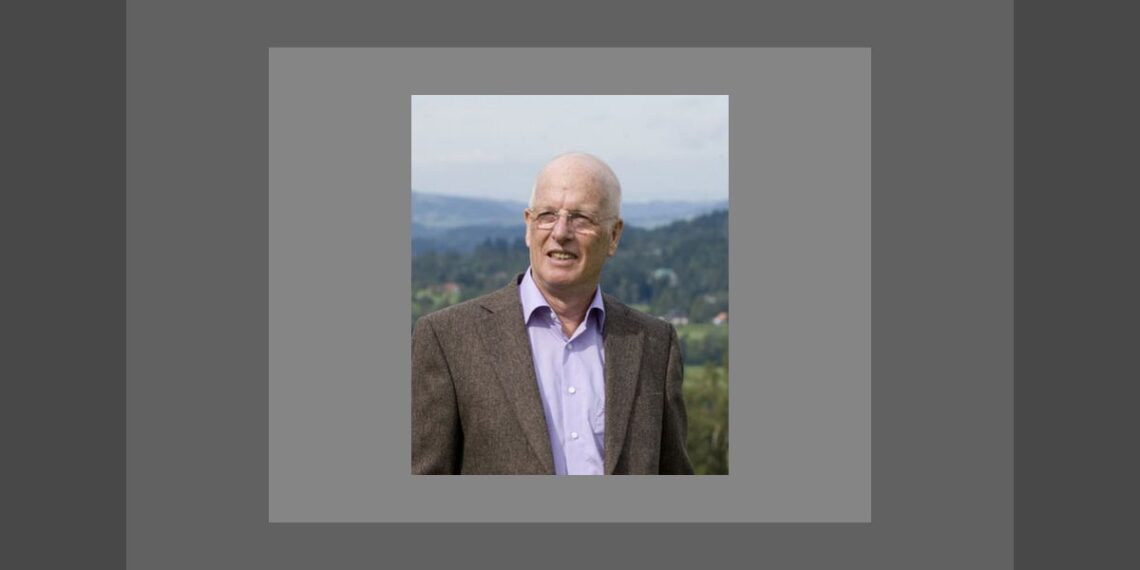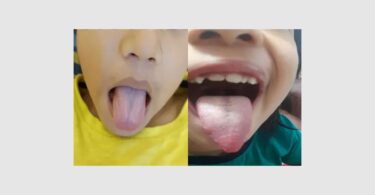
And now for your monthly slice from my book Looking Back Moving Forward (www.lookingbackmovingforward.com). This time I have chosen the inspirational and rule breaking Peter Chappell, world famous for his work with AIDS.
I found myself on Thursday 10 February 2005 taking the tube down to Shepherds Bush, West London, to the home of Peter Chappell. I had attended a lecture of his a few weeks earlier on his new remedies and I was keen to learn more about them and hear his story. He has been practicing as a homeopath since the renaissance, studied with Thomas Maughan, was a founding member and is a Fellow of the Society of Homeopaths, and he has a lot to say! It was a fascinating few hours.
Peter on Thomas Maughan and his influence on our profession and combination remedies
I fell in love with Thomas Maughan; a most amazing man. Of course I had treatment with him. He gave me Sulphur, which gave me a very deep spiritual experience. The remedy made me see myself exactly as I was – a very ordinary, poorly developed individual with endless weird thoughts and failings. I recognized a big long list of them and felt stripped of all pretentiousness and defenses. I saw that I was perfectly alright just as I was. That experience and process lasted about ten years.
First of all, Thomas gave me Morgan followed by Sulphur. He then gave me the tissue salts Natrum phosphoricum and Kali phosphoricum alternating to take three times a day. That was his first prescription and he had a routine. He said not to give the indicated remedy if you could spot it but to wait until you had worked on other levels first. Basically he knew about toxicity and detox, so he detoxed the body first, tuned it up, and got the person functioning better. Only then would he prescribe a constitutional remedy. He would know it by then anyway, or have a pretty good idea at least. This obviously had many advantages including stopping you needing to be spot on right at the start of treatment and to fully and deeply understand the person.
ROWENA: So was it because he wanted to get to know the person slowly?
PETER: No, he just wanted to make sure that they were ready for the remedy. His perspective was that if you give the indicated remedy when your patient is congested, for example, it isn’t going to have much of an impact because it cannot drive through the shit. If they are really full of toxins the indicated remedy won’t work properly so he prescribed routinely at the start of treatment using remedies to warm the person up.
He was inventing combination remedies at the time, which are still being used by homeopaths in the UK today. At the College of Practical Homeopathy (CPH) they talk about Ambra grisea, Anacardium orientale and Argentum nitricum in combination as Triple A. In those days he would think them up, order them from Galen’s pharmacy, and just see what happened. They have become folklore since but he was really just playing about.
He gave me Triple A once and one of them opened up my heart and had a very profound effect on me. I could argue for Anacardium orientale, I could argue for Argentum nitricum and could even argue for Ambra grisea, but one of them really deeply affected me and I will never forget it. It made me feel incredibly loving, as if my heart had opened and something shifted inside me. I think he christened it ‘the Love pill’ based on my response and that of others.
By the time I was about thirty I was starting to practice and I think it must have been around 1970. I didn’t know anything really but I thought you gave everybody remedies either in a 200C potency or 10M as their first prescription as that is what Thomas used to do. He would use a 200C for bowel nosodes and detox remedies followed by a 10M polycrest. I started practising using this system until I found my feet.
ROWENA: How long did you have to study with him?
PETER: Well, I didn’t have the opportunity to study any length of time, because after about two years he was dying; he even treated us in his pyjamas and dressing gown. He had very severe lung cancer, but he just didn’t want to give up smoking. I took him to see an acupuncturist in the final stages of his cancer and he was very impressed.
He used to love going out for the day; he didn’t drive at that point. We often went for breakfast to Galen’s, a homeopathic pharmacy in Dorset. He liked to leave at seven o’clock in the morning from South London before the rush hour and speed at ninety miles an hour along the not yet motorway roads to get to Galen’s pharmacy for ten in the morning to collect his remedies instead of having them posted to him. He just loved the idea of going out for a trip and he also gave me driving lessons. Because he was the Chief Druid of England at the time, he was a very heavy-duty spiritual teacher. He had a long white beard and he looked like the Asterix Druid.
When we drove to Dorchester, the roads were bad and if we didn’t overtake, the journey could take us all day. He would make me overtake on blind bends with only a fraction of a second’s notice to pull out. He was teaching me about consciousness; he was saying, “You have got half a second and if you take that half-second we could be out and back in before they know it” and I could. Just occasionally we would go around a blind bend and there would be a tanker coming towards us, and I would slam on the brakes and would just make it back in again in time. But those who drove him never had any accidents with him.
ROWENA: Why do you think he wanted to teach you that?
PETER: It was to sharpen up our minds. He came from the Golden Dawn Tradition; the true mystical and magical tradition of England. He knew a lot and had done a lot of things. He said he had to climb down several levels of consciousness before he could make contact with the people of my generation as they were pretty much wiped out by drugs. Even then he was having a hard time finding anybody to teach anything to. Anyway he was my introduction to homeopathy, and I just loved him! He also ran rituals in Druidism and other classes so I just queued up and took the whole lot. And while he was alive it was totally fantastic. It was quite good afterwards but his presence was all I really cared about.
Peter on Rajan Sankaran
And then of course Rajan Sankaran arrived on the scene and he was ace for me. He was about thirty then and it was like sitting at the feet of a master. He knew so much more than I did and he was stunning out there; honestly, I just lapped him up. He sat in a room for four days and we gave him all the difficult cases of Europe to treat. The patients would come in and sit down and he would then write the remedy on a piece of paper, screw it up and give it to us, not to open. Then he would take the case for an hour and go through it with us, explain all the rubrics and then we would open the screwed piece of paper up and there was the name of the remedy. He had already worked it out in one minute. He did that routinely, virtually every time. And he got it right and the results panned out just by making observations when the patient walked through the door.
He was really funny in those days. He would not look at the patient at all, he would just listen, and he would write down the rubrics as they came out in the case in the side margins and doodle on the main pages. He had no eye contact and we had to warn the patients about this. We learnt a lot from him, and he solved our difficult cases and made them look easy. Obviously over twenty years he has evolved and every time he writes a book he says it is a work in progress, which it is. Nowadays his focus is on the patient’s gestures so it is completely different. He has been going steadily step by step, and in Mumbai he has built up a base of people around him and they are all involved with each other.
I have never been to Mumbai, but I think that there is a great group of practitioners on the same wavelength who all work with his methods and they get good results. He says to understand the real person, watch their hand movements and their body language, and don’t take much notice of what they say. As I understand it, if you want to know their unconscious processes, their deepest forming forces, or the shape of which they really are in a primitive way, you need to look at their gestures, because sign language came before verbal language. If you watch their hands you get the sign language; if you listen to their voice you just get the chitchat. Obviously, that is a simplistic version of what he does, but it conveys the depth to which he now goes.
He has taken individual homeopathy, what I call the first simillimum, to its peak. If I was practising now I would spend some time getting myself to grips with Rajan Sankaran’s new system, so I was up to date. I would say that is where the energy is, if you want to be the best. Obviously, you can learn a lot from Rajan, from Jan Scholten, from Jeremy Sherr and all sorts of other people, who are great teachers.
Peter on the Second Simillimum and treating Cancer and AIDS
PETER: Having said that, I think what I have discovered is what I call the second simillimum, which is possibly the biggest step forward in homeopathy since Hahnemann. It is like the next step after Hahnemann because up until now what everyone has been actually doing is refining Hahnemann. However, no one had any idea about how you treat diseases. It is my conclusion that individual homeopathy never treats diseases, it treats people, it removes obstacles to vital energy flowing, which allows the disease to be overcome, but it doesn’t treat the disease. Now some very obvious remedies have affinities with diseases or certain types of pathology. Aurum metallicum and testicles, Sepia succus and fibroids, but that is because there is a relationship between the individual remedies inside a person and the disease simillimum.
For the first simillimum you must stick to the individual, and I would say you can forget anything in the repertory that has anything to do with pathology because it is at best only a confirmation and materia medica likewise. You can say it has got some indications in that way, but fundamentally you need to stick to the individual.
In my opinion, all chronic diseases are unique combinations of epidemic diseases. Epidemic diseases exist inside the same person for a long period of time; for example tuberculosis (TB) and malaria coexist together in Africa inside many people, it is just normal. There is no way that you can have only one disease at one time; everybody has got lots of miasms running all at the same time, it is just impossible for them not to. It is just a question whether the immune system keeps them under control or not. But if the person has AIDS or is subject to enormous trauma, the miasms start becoming active; the vital force cannot keep them under control and they just start to manifest.
Hahnemann says if you have got no symptoms, you have got no disease and there is no way that this can be true. That is only an ideal. There are lots of things that are wrong with what Hahnemann said, but you know he wrote the Organon two hundred years ago, for heavens sake, and things have moved on. I have written a book called The Second Similimum and in it I have pulled homeopathy apart, reformed it and said what I think about it. I might be completely wrong in some of my formulations, but I had a go at it based on my experience of homeopathy.
What I observed was that things join together in the microcosmic world by symbiosis, and in the real world they do too. Turtles have fish that swim with them to keep them clean. Buffalo have birds that sit on them to keep them clean and eat the flies. Symbiosis is everywhere. Inside our guts we have enormous numbers of bacteria to help us eat and snails have certain animals inside them to help them eat too and without those they couldn’t live. I think diseases are combinations of miasms and therefore you can treat diseases like chronic miasms; you just take the totality of a disease and you find the remedy and prescribe it.
Carcinosin is not a miasm; it is the first example of a disease remedy. I am not breaking new ground here. Donald Foubister said how brilliant Carcinosin was in treating incipient cancer, and it is pretty close. It is brilliant and totally curative at times. I have a case in my book, Emotional Healing with Homeopathy, with a seven year follow up; complete cure of diagnosed cancer based on one dose of Carcinosin.
ROWENA: Is that because it matched the situation?
PETER: Yes, but it should do. Unfortunately, the reason why Carcinosin generally doesn’t work is because there should be a hundred different samples in there of different types of cancer. Or you could take a Carcinosin made typically from ten people with a typical cancer you are working with. You could have cancer of the testicles or cancer of the prostate. Ten different men with prostate cancers from around the world, all samples mixed together at the same time by some intelligent process and made into one remedy. Then you have got a remedy that has got a possibility. At the moment we have one remedy for cancer and it clearly doesn’t work. If it did then the Ramakrishnan method wouldn’t have evolved. So I have worked out a different way of making remedies, which does work, and I now have remedies for miasms and remedies for diseases.
ROWENA: So have you been using your Cancer remedy to treat people with cancer?
PETER: Well I don’t treat people except in Africa; I wait for other people to get me the evidence. Also it is more convincing if other people do so. Disbelief was a real issue for me in Africa with my remdy for AIDS, PC1 remedy, so it was good that practitioners other than me treated patients and they got the same results. So my system seems to work and I have got enough results now to show that it seems to work across the board. There are results for cancer treatment documented on my web site with two year follow ups, but not enough results by a long way.
ROWENA: Are your results mainly for your AIDS remedy then?
PETER: My early results are all AIDS. Later I started work on chronic diseases. While not everybody gets a result the first time they used one of my remedies, sometimes they get a fantastic result beyond anything they have previously experienced. In some cases practitioners have given patients who have been treated for twenty years without a very satisfactory result, one of my remedies and they have responded very dramatically and successfully.
Peter on the shortcomings of our education system
On a different subject, I have to say one of the weaknesses I perceive in homeopathy is that homeopaths are not sufficiently trained; they haven’t done enough internal, therapeutic inner training. The world is emotionally illiterate and I think emotional intelligence in homeopathy is still limited. The results of critical life events and emotional trauma are often in the way when we are seeking the individual simillimum and we shouldn’t be giving an archetypal simillimum at that time, but a traumatic one and that is usually enough. Most people go back to functioning okay when they have dealt with their trauma.
There is a constitutional pattern below the trauma that is archetypal and comes from the animal, mineral or vegetable kingdom and it might be a very satisfactory life pattern and doesn’t always need treating. You could treat it, and it will open up a whole lot more if the life pattern is too constrictive. You often see by giving the remedy for that life pattern, that the person will open up and their energy will flow more efficiently. But the traumatic pattern is often laid on top of that, and I think homeopaths are not trained enough in that area and they don’t understand themselves sufficiently, and therefore they don’t understand this. You cannot understand other people without understanding yourself; that is a given. What is often not recognised is that the trauma miasm – if we can call it this – is in the way of the deeper archetypal remedies and the trauma needs to be treated first. Traumas pass down from generation to generation, as I have shown in my book Emotional Healing with Homeopathy. It is common and is a dominant part of human make-up.
Sexuality is such a good example of an area where there is insufficient training. If a group of homeopaths went on a weekend course in sexuality training, I bet you on Monday morning when their patients sit in front of them again they would be asking questions they have never asked before. And they would be getting information or responses they have never had before, because they would then be much easier with the subject. And that is the same with all these areas.
Another area where homeopathy is relatively undeveloped is belief systems. I figured out that there are a whole lot of remedies out there in the ‘belief structures realm’, which are different from anything that we have proved before, because we don’t deal with belief structures. You can give people really good remedies but their beliefs won’t change. All sorts of other things change, but their beliefs stay the same. I have developed remedies that work on that level too.
My thought process behind this is based on my perception that the spiritual realm is the only solid reality; the rest of it is rolled out by our mind and is not grounded in reality. Being in a physical body is an enjoyable learning experience but it is not solid reality. The spirit is what is solid and we choose to roll out a body every now and then by a process we have evolved. So I started rolling out remedies for belief structures, and a simple but profound example is fat and famine. My Fat remedy is brilliant because there is a belief structure that there isn’t enough food to go around. That is an easy one to understand.
ROWENA: So you wouldn’t give it necessarily to someone who was overweight, because there are lots of different reasons why people are overweight, only if they have that belief system in their consciousness?
PETER: I would prescribe it when there is an eating disorder related to there not being enough food. But the whole human race has been through that issue as poverty and malnutrition were epidemic for centuries; you don’t have to go back too far before people were dying because they were starving in the winter. In a way, it is a trauma miasm. They wouldn’t be aware of it; it is completely unconscious and there is no way that you can approach the consciousness of that one. You can acknowledge that you are fat but you won’t know that it might be because of a very deep issue.
ROWENA: I hope you enjoyed reading this extract from Peter’s chapter in Looking Back Moving Forward. I would very much welcome a worldwide discussion on the issues raised by Peter If you visit the blog on my website, www.lookingbackmovingforward.com, you can make your contribution and also receive a ten percent discount if you buy the book. For those of you who tried last month to reach the blog but were unsuccessful – apologies. Those problems should now have been rectified and I welcome you to try again. Many thanks!
Long live homeopathy!




